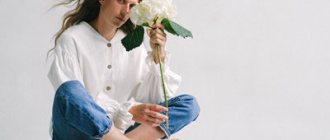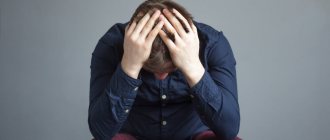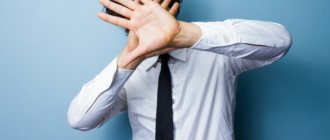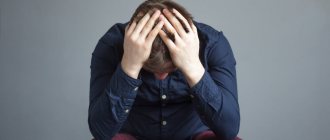Long eyelashes, thick eyebrows, beautiful, well-groomed hair are indicators of natural beauty.
Therefore, trichotillomaniacs are often rejected and ridiculed by society. The term trichotillomania comes from the Greek words trichos (hair), tillo (pulling out), mania (attraction). This is an impulsive mental disorder, expressed in an irresistible urge to pull out hair in different parts of the body. It was first described in 1889 by the French dermatologist Allopo F.A.
Symptoms of trichotillomania
The symptoms of trichotillomania are visible to the naked eye. A person pulls out his own hair on his head, pubic area, eyelashes and eyebrows. At the initial stage, a small amount of hair falls out; in the future, the lesions will increase depending on the severity of the disease.
As a rule, a person twirls the hair on his head around his finger and then pulls it out; he removes eyelashes and eyebrows using tongs or other devices.
Patients pull out hair during stress (even the slightest), as well as while performing some monotonous activities (watching TV, reading a book, talking on the phone, etc.).
The skin on the damaged areas is completely healthy, without redness. However, there are times when the patient scratches areas of the skin until it bleeds.
In 10% of cases, patients eat plucked hair and also bite their nails. This leads to disturbances in the functioning of the gastrointestinal tract, the appearance of trichobezoars in the stomach (hair stones), and dental problems. Also considered complications of the disease are inflammation of the skin and eyes caused by infection.
STORY
The term “trichotillomania” was introduced in 1889 by the French dermatologist Francois Henri Hallopeau (1842-1919), who presented the medical community with the medical history of a young man suffering from itching of the scalp. When the itching became unbearable, the patient would tear out his hair in passion. The phenomenon was called trichotillomania. The name comes from three Greek words: trich - hair, tillo - tearing out, pulling out, mania - pathological attraction. Francois Henri Hallopeau In 1968, ED Vaughan, JL Sawyers and HW Scott described Rapunzel syndrome (named after the main character in the Brothers Grimm fairy tale of the same name about a girl with very long hair) - a type of intestinal obstruction caused by the systematic ingestion of hair (trichophagia), resulting in which causes a conglomerate consisting of hair (trichobezoar) to form in the stomach and small intestine. FV Mannino and RA Delgado in 1969 noted that TTM occurs more often in girls than in boys. In their opinion, the main cause of the disease is the disharmonious relationship between mother and child in early childhood, and TTM can only be treated with psychotherapy. In the domestic literature, O.B. was the first to describe TTM. Feltsman in 1918. In the USSR, the most patients were analyzed by V.I. Garbuzov (1971) and V.M. Bykov (1983).
Causes of trichotillomania
The nature of trichotillomania is not fully understood today. As a rule, the causes of trichotillomania are associated with mental disorders (neurosis, schizophrenia, stress, depression, obsessive-compulsive disorder), however, it can also be a consequence of a lack of iodine and copper, insufficient amounts of vitamins, head injury or concussion, thyroid disease , allergies to drugs or chronic tonsillitis.
By tearing out hair, patients try to suffocate mental pain with physical pain. They often deny there is a problem.
The Salvation psychiatric clinic employs professionals who can correctly determine the cause of the disease, which will allow the problem to be solved faster.
Not long ago, scientists proved that people who suffer from this disease have a damaged gene. This phenomenon is still poorly understood, so it is difficult to make assessments. The disease is often hereditary, which supports the theory.
Trigger
According to official data, about 5% of people worldwide suffer from trichotillomania. But this figure is inaccurate, since the lion's share of patients hide their addiction. People are able to hide their addiction for 20 years.
The majority of patients are women. More often, the disease debuts in childhood or adolescence, less often in the range of 20-30 years, and even less often after 40.
The development of the disease is based on the emerging feeling of tension and anxiety. The cause may be a guilt complex, fear, anger, anger and many other conditions that provoke a feeling of anxiety.
The skin where hair grows is well innervated thanks to a dense network of nerve fibers. This increases her sensitivity. A person who pulls out a hair feels pain. In this way, the patient switches attention from mental stress to physical sensations.
Self-inflicted pain acts as a way of self-punishment. Trichotillomaniac uses this method to relieve the stress that torments him. Endorphins, released under the influence of painful impulses, give a feeling of satisfaction, but only for a short time. Soon the feeling returns. The process is repeated.
There is an assumption that the disorder can also satisfy masochistic desires. Allegedly, the patient deliberately intensifies the pain in order to subsequently receive pleasure when the pain subsides. But this theory is just a guess.
Trichotillomania in adults
Trichotillomania in adults is more pronounced. Often, in the initial stages of the disease, adults try to hide the problem with the help of wigs, cosmetics, eyebrow tattooing, etc. Because of this, it can be difficult to identify the disease right away, which leads to complications in treatment.
Women suffer from trichotillomania almost 2 times more often than men. This is largely due to the fact that women pay more attention to their appearance.
Sometimes the disease begins with the pulling out of gray hairs. Some patients complain that the head begins to itch and after pulling out the gray hair, the tooth stops.
EPIDEMIOLOGY
Previously, it was mistakenly believed that TTM was an extremely unusual and rare disease. However, epidemiological studies have shown that TTM affects from 1-3% to 5% of the planet's population. Among the patients, females aged 11-16 years predominate. There is an opinion that the real number of cases of TTM is underestimated due to the denial of their behavior by some of the respondents, as well as their tendency not to seek help. This may particularly apply to men who claim androgenetic alopecia to hide their condition. In addition, practicing dermatologists are often unaware of the existence of this disorder and may not ask patients whether they pull out hair.
Trichotillomania in adolescents
Trichotillomania in adolescents may be associated with hormonal changes in the body or with psychological disorders. At this age, a person reacts very sharply to what is happening, so problems in the family, frequent quarrels between parents or their indifference to the child’s problems, ridicule from peers and problems with socialization lead to a worsening of the condition.
Teenagers suffering from trichotillomania try to avoid contact with people and spend most of their time alone.
The task of parents is to find a common language with the child, stop criticizing over trifles, help him socialize and solve psychological problems.
If the problems are related to hormonal changes, then medications can be effective. They are prescribed by a doctor after consulting an endocrinologist and passing all the necessary tests.
Diagnostics
When diagnosing trichotillomania, it is necessary to exclude diseases such as fungal infections and syphilis, in which complete baldness is observed. Diagnosis of trichotillomania is based on examination of the patient and interviews with the patient and his family members. The doctor should collect the following information:
— what worries the patient;
- what diseases have you been ill with recently?
— whether there are hereditary diseases in the patient’s family members;
- what medications have you used recently?
- what is the daily routine, nutrition, physical activity.
After the interview, the doctor examines the patient:
— the doctor assesses the fatness of the head;
- examines hair for fragility, lack of shine, split ends;
— examines the scalp for dermatological problems (inflammation, flaking, etc.);
— determines the presence, location, degree of hair thinning;
— determines the type of hair loss (scarring, non-scarring).
Treatment of trichotillomania
Treatment of trichotillomania begins with diagnostic measures: it is necessary to exclude the possibility of fungal diseases and syphilis. The patient also needs to undergo a general blood and urine test so that the doctor can assess the general condition of the body.
At this stage, the doctor interviews the patient and his relatives, finds out the patient’s diet and habits. It is also necessary to consult a dermatologist, neurologist and endocrinologist. This will help identify concomitant diseases. If the patient eats his hair, a consultation with a gastroenterologist may also be scheduled.
At the initial stage, it is very important to determine the cause of the disease. 60% of the success of treatment depends on this.
Due to the fact that the nature of the disease is still poorly understood, it is treated using the same means as for other psychological diseases - sedatives and antidepressants. Radiotherapy is also used to stimulate the spinal cord roots. Drug treatment in children is not effective.
The doctor necessarily prescribes a diet rich in iodine and copper, vitamin A, and prescribes vitamin-mineral complexes.
Patients have their scalp and pubic hair completely shaved and their eyelashes and eyebrows removed. Such measures have a short-term effect (until the hair grows back), but during this time it is possible to provide psychological support to the patient and eliminate the causes of the disease. Doctors also recommend wearing a special headdress that makes it impossible to pull out hair.
Great attention is paid to providing psychological support. Psychologists work with patients both individually and in group sessions. In addition, hypnosis and cognitive behavioral psychotherapy are actively used. They can be very effective.
General therapy also includes the treatment of eye or skin diseases that appear as a result of trichotillomania.
PsyAndNeuro.ru
Trichotillomania is a condition in which people experience an obsessive urge to pull out their hair, leading to thinning hair. This disorder affects approximately 0.5-2.0% of the population. In the DSM-5 (and the future ICD-11 - editor's note), trichotillomania is classified under obsessive-compulsive and related disorders.
Behavioral therapy has been successfully used in the treatment of trichotillomania, but not all patients are willing or able to comply with this treatment strategy, so there is a need for effective pharmacological treatment options. Historically, pharmacotherapy for the treatment of this disorder has been largely ineffective, but some findings have emerged in this regard. Fluoxetine, clomipramine, olanzapine, and naltrexone have been used in the treatment of trichotillomania, but evidence of their effectiveness has been varied and side effect profiles have limited practical application. Recent advances in understanding the pathophysiology of trichotillomania, as well as evidence of the effects observed with certain glutamate modulators such as N-acetylcysteine and dronabinol, have provided new potential pharmacotherapy options.
Criteria for trichotillomania in DSM-5:
- Repeated hair pulling leading to hair lossB. Repeated attempts to reduce or stop hair pulling
- Hair pulling causes significant distress or impairment in social, occupational, or other important areas of functioning
- This condition is not associated with other medical diseases (for example, dermatological)
- Hair pulling cannot be explained by the presence of another mental disorder (for example, attempts to improve a perceived defect or flaw in appearance in body dysmorphic disorder)
A recent study noted that the average age of onset of trichotillomania differed significantly between men and women. The overall mean age of illness was 17.7 years, the mean age in women was 14.8 years and 19.0 years in men.
The most common places where patients pull out hair are the scalp, eyebrows, pubic area, eyelashes and beard.
Dermoscopic features of trichotillomania include decreased hair density, brittle hairs of varying lengths, coiled or short vellus hair, trichoptilosis (split ends), occasional yellow spots, and absence of hair in the area as in alopecia areata.
Two different types of trichotillomania have been described, "automatic" and "focused", but most people show signs of both types. People with the automatic type are often unaware that they are pulling their hair, while people with the focused type often describe the experience of hair pulling as an integral part of their condition. Patients describe a feeling of pleasure or a decrease in negative emotions during hair pulling.
Three main additional variants of psychodermatological trichises that lead to hair loss have been described: trichotheiromania (rubbing/combing the affected area), trichotheomania (shaving/cutting) and trichodaganomania (hair biting).
Trichotheiromania is often treated with high doses of glucocorticoid creams, with varying effectiveness. A case report showed a good response to N-acetylcysteine treatment in a 47-year-old man who had partial improvement after eight weeks and full hair regrowth after 16 weeks after treatment with 1200 mg N-acetylcysteine per day.
Treatment includes both psychotherapeutic and pharmacological interventions. Treatment recommendations depending on the patient’s age:
- Preschool age. In this age group, trichotillomania is seen as a habit disorder similar to thumb sucking and goes away on its own. Parental support and education about the benign course of the disorder are most effective.
- School age. At school age, behavioral approaches were found to be more effective than pharmacotherapy. Because of the possibility of comorbid psychiatric disorders, psychiatric referral is warranted in this age group.
- Teenagers and adults. The most effective combination of psychopharmacotherapy, behavioral therapy and treatment of concomitant mental disorders
Cognitive behavioral therapy
Behavioral pattern replacement training is a type of CBT that is used as a 1st line of non-pharmacological intervention for trichotillomania. This therapy involves helping the patient become more aware of their hair-pulling behavior and its context, and then replacing that behavior with another behavior—such as making a fist that can be held until the pull subsides. hair pulling.
Stimulus control training
Stimulus control training involves changing a person's environment to make it less conducive to hair pulling. This may include removing things that make hair pulling easier or adding things that discourage the behavior. Examples include removing mirrors or adding an object that occupies the patient's hands, such as a stress ball or spinning object.
Acceptance and Commitment Therapy
Acceptance and Commitment Therapy attempts to help patients achieve hair-pulling behavior in terms of interfering with personal or life goals.
Although there are no FDA-approved medications for the treatment of trichotillomania, due to the condition's comorbidity with other psychiatric disorders, first-line pharmacotherapy usually consists of selective serotonin reuptake inhibitors (SSRIs) or the tricyclic antidepressant clomipramine.
Tricyclic antidepressants
In a placebo-controlled study, Ninan et al found that CBT was more effective than clomipramine and placebo. Clomipramine was found to reduce trichotillomania symptoms more than placebo, but the difference was not significant. However, there has been a case report of successful clomipramine monotherapy at a dose of 125 mg/day and clomipramine 50 mg/day therapy in combination with CBT.
SSRIs
SSRIs are widely used to treat trichotillomania in both adults and children, but evidence of benefit is weak. In animal models, SSRIs have been shown to reduce excessive grooming in mice, the genetic characteristics of which are associated with the pathogenesis of trichotillomania. In human studies, a meta-analysis by McGuire et al found a modest effect with SSRIs in the treatment of trichotillomania. However, a previous meta-analysis showed that clomipramine was more effective than placebo, but this pattern was not observed for SSRIs. A small, open-label, 16-week study showed the effectiveness of fluoxetine at doses up to 80 mg/day in reducing hair pulling, but the study did not include a control group. Placebo-controlled, double-blind studies did not show a significant benefit of fluoxetine compared to placebo. Since people with trichotillomania often have comorbid mental disorders such as depression and anxiety, there is every reason to include SSRIs in the treatment plan for such patients.
Antipsychotics
Antipsychotics have been considered as potential drugs for the treatment of trichotillomania due to their effectiveness in treating tics and the frequent comorbidity of trichotillomania and tic disorders. The most studied drug in the treatment of these patients was olanzapine, but there is evidence of the effectiveness of risperidone and haloperidol. However, we should not forget about the serious side effects that occur during antipsychotic therapy and weigh them against the potential benefits in the treatment of trichotillomania.
Opioid antagonists
The mechanism of action of these drugs in the treatment of trichotillomania is likely to be by reducing the chemical reward of hair pulling. Unfortunately, in a double-blind randomized controlled trial by Grant et al, naltrexone did not show a significant difference in reducing hair pulling compared with placebo in the treatment of trichotillomania, although it did significantly improve cognitive flexibility.
N-acetylcysteine
The mechanism of action of N-acetylcysteine in neurological and psychiatric disorders is not entirely clear, but may help protect against a number of pathological processes such as oxidative stress, neuroinflammation, glutamine and dopamine dysregulation. For impulse control disorders, including trichotillomania, N-acetylcysteine is thought to act primarily by regulating synaptic glutamate levels in the brain and reducing cytotoxicity. Evidence of the effectiveness of N-acetylcysteine in the treatment of trichotillomania varies from study to study. In the two main placebo-controlled studies conducted, one showed a significant benefit over placebo, while the other did not.
A 2009 double-blind, placebo-controlled study that examined N-acetylcysteine in 50 adults with trichotillomania found that N-acetylcysteine at a dosage of 1,200 mg twice daily showed significant benefit compared with placebo.
Because of its relative safety and tolerability compared to other treatments for trichotillomania, such as antidepressants or antipsychotics, and its low cost, N-acetylcysteine may become an important treatment option for those struggling with this disorder. However, further research is needed, including larger, long-term, randomized, placebo-controlled trials with more standardized outcome measures.
Milk thistle
Milk thistle has been shown to have antioxidant properties and is invaluable in the treatment of trichotillomania. A recent double-blind, placebo-controlled crossover study found that milk thistle had no significant benefit over placebo in reducing the severity of trichotillomania as assessed by the National Institute of Mental Health. However, a benefit was found in terms of Global Clinical Impression Scale score and reduction in time spent pulling hair per week. The study involved 20 people aged 12-65 years, 19 of whom were women.
Probiotics
The gut microbiota is thought to influence behavior in several ways. These include effects on vagus nerve signaling (possibly through serotonin synthesis by enterochromaffin cells), mineral metabolism, modulation of circulating cytokine levels, and changes in neurotransmitter turnover. In addition, changes in neurotrophic factor gene expression, SCFA-mediated modulation of G protein-coupled receptors, and changes in the hypothalamic-pituitary axis may also play a role.
Animal studies have shown that gut microbiota may also influence mammalian brain development, including the development of the striatum, which (among other brain regions) is structurally abnormal in individuals with trichotillomania.
Dronabinol
Dronabinol, a cannabinoid agonist, may provide potential benefit in the treatment of trichotillomania by reducing glutamate cytotoxicity in the striatum. In a small open-label study, dronabinol showed a significant benefit in reducing hair pulling in 9 of 12 patients.
Inositol
A proposed potential mechanism of action of inositol on psychiatric disorders is by attenuating serotonin-2 receptor desensitization, as the phosphatidylinositol second messenger system is used by these receptors. In a double-blind, placebo-controlled study, Leppink et al found that inositol had no significant benefit over placebo. The study lasted 10 weeks, and of the 38 participants, the majority were women. 19 patients received inositol, the remaining 19 received placebo.
Trichotillomania is a complex psychodermatological disorder that still requires much research regarding its pathogenesis and pharmacological treatment. Research into the comorbidity and genetics of this condition has shown potential for future research and new strategies for personalized treatment. In addition, some new pharmacotherapy options, including monotherapy or adjunctive therapy, show promise. Notably, N-acetylcysteine appears to be a well-tolerated and safe potential treatment for adults with trichotillomania. Another option includes complementary treatments such as probiotics and the cannabinoid agonist dronabinol, but more research is needed.
Author of the translation: Gadzhieva F.Sh.
Source: Everett GJ, Jafferany M, Skurya J. Recent advances in the treatment of trichotillomania (hair-pulling disorder). Dermatol Ther. 2020;e13818. doi:10.1111/dth.13818
Treatment of trichotillomania at home
Treatment of trichotillomania at home is effective only if the cause of stress has been completely eliminated. The most effective treatment is considered to be one in which the patient underwent a course of psychotherapy in a medical institution, and then returned home, where he continued treatment. As you know, houses and walls are treated, conditions are better than in a hospital.
As for trichotillomania in children and adolescents, the disease goes away quite quickly as soon as the parents are able to come to an agreement among themselves and reconsider their views on raising a child.
The attending physician continues to advise the patient and his relatives on treatment issues, and if a relapse occurs, the patient must be immediately taken to the facility.
Etiology of trichophagia:
Most psychiatrists agree that the reasons for the development of trichophagia may be, in particular:
- Deficiency of maternal love;
- Fear of being alone;
- Death of loved ones;
- Alcoholism and drug addiction;
- Depression;
- Inferiority complex.
As you have already noticed, there are all the prerequisites for the onset of the disease in childhood, including early childhood. And indeed, the tendency to the pathology in question really manifests itself quite early. Indirectly, children who twirl their hair around their fingers can be considered a “risk group” during experiences or moments of concentration.
Usually, children understand well that eating hair is bad, they try to hide their desire to do this from adults, and retire to indulge in trichophagia. Children deviate from relevant questions and hide the habit from parents and doctors.
Regarding character, such children have excellent communication skills, developed leadership qualities and good performance in school. Often, these children grow up in authoritarian families, where pedantry and adherence to clear rules are encouraged. Eating hair can be triggered by a feeling of discomfort and guilt when deviating from the algorithm of behavior set by strict parents.
Reviews about the treatment of trichotillomania
Reviews about the treatment of trichotillomania at the Salvation psychiatric clinic are only positive. Real professionals with extensive experience work here who can cope with even the most complex problem. They will find a caring approach to each patient and will make their stay at the center more pleasant and comfortable. Doctors work not only with the patient, but also with his relatives, which allows them to eliminate the cause of the disease.
The center is located away from the noisy city in an ecologically clean area. This allows patients to enjoy nature and walk around the center.
The center itself has all the necessary equipment and medications for the treatment of many psychological diseases.
A clear advantage of the center is good living conditions. The buildings have been renovated, all rooms are equipped with everything necessary.
Treatment at the center is carried out anonymously, which will not negatively affect the patient’s reputation. After completion of treatment, the center’s workers will help the person socialize and even get a job.
general information
Getting rid of hair on the head, under the arms, in the pubic area and other places of the body often accompanies a number of mental illnesses or indicates extreme nervous imbalance of the patient. And treatment of trichotillomania should begin with identifying the factors contributing to its development. The disease is registered in women twice as often as in men. Often combined with trichaphagia. With such a deviation, when examining the patient, areas of baldness, single or multiple, are noted. They are characterized by a symmetrical location and unchanged skin in the affected area.
When interviewed, it turns out that the person does not pay attention to such behavior and even denies self-damage to his hair. There are variants of trichotillomania, in which the patient complains of itching of the scalp and pulls out exclusively gray hair, supposedly in this way alleviating his condition. According to the international classification, this pathology was classified as a desire disorder.
According to the latest research data, it was found that many patients with this diagnosis have a damaged certain type of gene. If such a theory is clearly confirmed, then it will be possible to carry out etiological treatment of trichotillomania.









